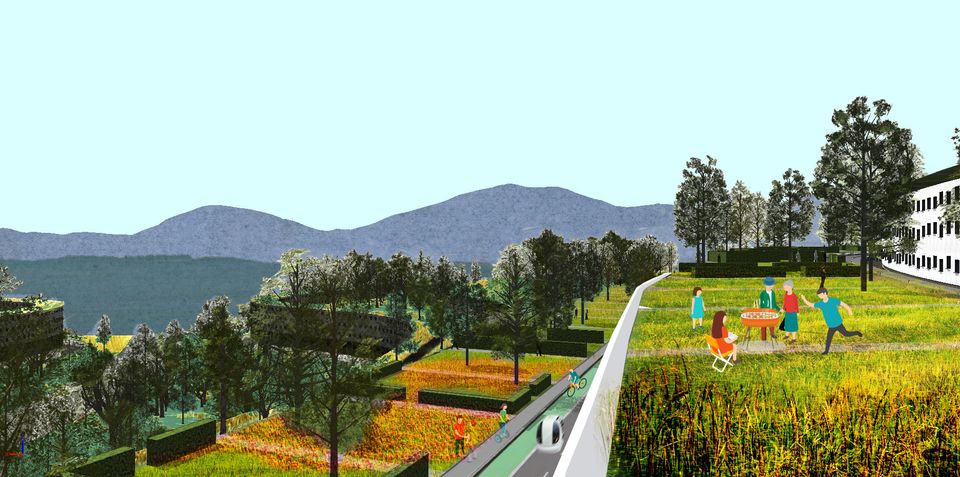Housing an Aging Population

An inevitable, meaningful challenge.
There is a beautifully designed book published a few years ago called New Aging. According to its author Matthias Hollwich, it began when he turned 40 and realized that half of his life had gone by already. What troubled him more, though, was what awaited him in the years to come: the prospect of spending his last years inside a dull and uninspiring nursing home. It was this anxiety that prompted him to find out how we can better live our lives such that we maintain a healthy, energetic, and happy lifestyle, even in old age.
Hollwich was not alone in detecting a strategy for aging. Recently, aging itself has become a subject of much investigation, giving rise to new ideas that fall under the notion of “active aging,” which the World Health Organization defines as “optimizing opportunities for health, participation and security in order to enhance quality of life as people age.” Note the emphasis on “quality of life”: Rather than framing aging as a matter of healthcare or welfare, “active aging” posits aging as a positive experience, maybe even something to look forward to.
What, then, counts as a good life? This is one of the most important questions that philosophers such as Aristotle have turned to over millennia. Chief among the traits of a life well-lived, according to Aristotle, is the ability to be self-sufficient and live within a community. Yet, much of what we currently think of old age, at least before “active aging”, neglects these quintessential aspects of the good life. When elderly are put into nursing homes, not only do they lose the sense of self-sufficiency, they are also being cut off from the network of social ties that supply a sense of purpose. It is no surprise that over 80% of elderly are clear about not wanting to move into a nursing home.
However, staying out of the nursing home comes with a set of requirements. After all, most elderly are put into nursing homes not because they voluntarily opted for it, but because either they or their family are no longer able to take care of them, owing to decreasing physical capability, a lack of time, or many other reasons. If elderly are to age independently, there needs to be a network of support outside the institution of nursing homes.

There are complications to re-creating this support system, though. At the individual level, the pressure of the workplace exerts ever increasing demand on the time and energy of the working generation. Spending time to look after the elderly has become not just challenging in its own right; it is almost a luxury of time. This individual dilemma can, in turn, be linked to a broader culture of individualism that has coincided with the decline of the family. It means not only that family no longer takes priority, but that, more and more, there are not even families to speak of.
Today, almost one in three adults in Hong Kong never marry. Divorce rate has more than tripled since 1991. What will happen when this generation enter into old age? Currently, about 120,000 elderly live on their own, a figure that will almost certainly continue its upward trajectory. Is this life of solitude what we look forward to? Is it what we spend our lives working tirelessly towards?
The good news is that none of this is inevitable. Already, many creative proposals have been advanced, in addition to those included in New Aging. One such solution is innovative urban design that makes it easy for elderly to maintain an active lifestyle.
In Toyama, Japan, for example, under the mayorship of Masashi Mori, public transportation has been redesigned to make it easily accessible for the city’s elderly. Buses offer door-to-door service for those who will not otherwise leave their homes. The city health center emphasizes preventive care so that illness will not interfere with social activities. The goal, which the manager of the center puts quite plainly but ambitiously, “is for older people to stay at the same level of fitness or even improve.”
At a smaller scale, though no less transformative, universities in New York and Chicago have started to pair their students with elderly who have extra rooms in their homes. These students, in exchange for a reduced rent, help perform some of the household duties that the elderly cannot perform. Both are better off as a result of this partnership, but this is far from being the only benefit. More important, for both the young and the young-at-heart, it provides an opportunity to foster friendships that would otherwise never be, and reinforces social bonds across generations.

What these initiatives have in common is their emphasis on connectivity and community. The scientific consensus is clear: social isolation kills us. People who live alone with little social interaction are more likely to experience stress and depression. But the impact of isolation is more than psychological. Physically, too, it negatively increases risks of cardiovascular diseases and other illnesses. On the other hand, when people live in a community, both their physical and mental health improve. By promoting social connectivity — not the virtual social media-based type, but living, face-to-face relationships — these initiatives provide an effective antidote to the perils of aging.
In the next 20 to 30 years, about 1.4 million more people in Hong Kong will be 65 or older, the legal definition of a senior citizen. This brings the total elderly population up to about 34%. Many existing services such as nursing homes and healthcare will no doubt remain indispensable, but we should not limit the future to these possibilities only. New ideas that keep the people inspired and energetic keep the city alive as well.




